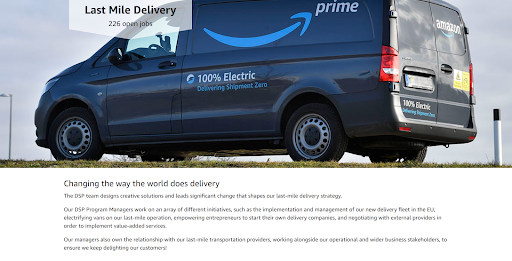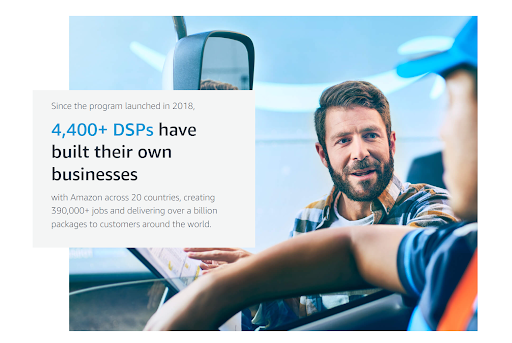What is Last-Mile Delivery for Bulk Orders? | Amazon DSP

Introduction
Last-mile delivery is a critical component of the supply chain, representing the final step where goods are delivered from a distribution center to the end customer. While last-mile delivery for individual packages is widely understood, bulk orders pose unique challenges that require a different approach. For businesses dealing with large quantities of goods, whether in B2B transactions or large-scale consumer deliveries, optimizing last-mile delivery is crucial to meeting customer expectations and controlling logistics costs. In this blog, we’ll explore what last-mile delivery for bulk orders entails, the common challenges businesses face, and strategies to streamline this process for better efficiency and cost management.
1. What is Last-Mile Delivery?

Last-mile delivery refers to the final leg of the logistics journey, where products are transported from a distribution hub or warehouse to the customer’s location. It is often considered the most complex and expensive part of the supply chain, accounting for nearly 53% of total shipping costs. The primary goal of last-mile delivery is to ensure timely and accurate delivery while meeting customer expectations for convenience and speed.
- For bulk orders, last-mile delivery involves transporting large quantities of goods to a single or multiple delivery points, such as retail stores, warehouses, or industrial sites. Unlike individual parcel deliveries, bulk order last-mile logistics require special handling, larger vehicles, and more precise scheduling.
2. Key Differences Between Last-Mile Delivery for Bulk Orders and Individual Parcels
While the basic concept of last-mile delivery remains the same, handling bulk orders involves distinct requirements:
-
Delivery Vehicles:
For bulk orders, larger vehicles like trucks, trailers, or even specialized freight carriers are often used, as opposed to vans or motorcycles commonly used for individual deliveries. -
Handling Requirements:
Bulk deliveries may involve pallets, crates, or containers that require loading equipment like forklifts, making the process more complex compared to individual package drop-offs. -
Delivery Points:
The destinations for bulk orders may include warehouses, retail stores, or commercial sites rather than residential addresses. This means deliveries may need to be coordinated during business hours or require appointments. -
Scheduling Flexibility:
While individual parcel deliveries prioritize speed and flexibility, bulk deliveries often need to be scheduled precisely due to the logistical demands of handling large quantities.
3. Common Challenges in Last-Mile Delivery for Bulk Orders

Handling last-mile delivery for bulk orders presents unique challenges that can impact efficiency and costs:
-
High Delivery Costs:
Larger vehicles, specialized equipment, and increased fuel consumption contribute to the higher costs associated with bulk last-mile delivery. Additionally, multiple delivery stops can increase labor expenses. -
Complex Routing:
Finding the most efficient route for multiple bulk delivery points can be difficult, especially in urban areas with traffic restrictions or limited access for large vehicles. -
Handling Delays and Scheduling Conflicts:
When delivering to commercial sites, delivery times may need to be scheduled in advance, and delays can cause disruptions in operations. For example, a delayed delivery to a retail store could result in out-of-stock situations. -
Storage and Handling Requirements:
Bulk orders often need special storage conditions or handling equipment at the delivery location, which requires coordination between the shipper and the receiver. -
Customer Expectations:
Businesses expect deliveries to be on time, complete, and undamaged. Any disruptions in the last-mile delivery process can affect customer satisfaction and lead to costly returns or penalties.
4. Best Practices for Optimizing Last-Mile Delivery for Bulk Orders

To overcome the challenges associated with bulk last-mile delivery, businesses should adopt strategies that streamline operations and reduce costs:
-
Use Advanced Route Planning Software:
Investing in route optimization tools can help businesses find the most efficient delivery routes, minimizing travel time and fuel consumption. Such software can factor in variables like traffic conditions, delivery time windows, and vehicle capacities. -
Leverage Real-Time Tracking and Communication:
Implementing GPS tracking and providing real-time updates to customers can help manage expectations and improve transparency. This allows customers to prepare for deliveries, reducing potential delays and missed appointments. -
Consolidate Shipments Where Possible:
Consolidating orders for the same delivery area can reduce the number of trips required, cutting down on fuel costs and delivery time. This is especially beneficial for deliveries to multiple retail stores or distribution centers. -
Employ Specialized Vehicles and Equipment:
Using vehicles equipped with lift gates, pallet jacks, or refrigerated storage (for temperature-sensitive goods) can make deliveries more efficient and ensure that bulk items are handled safely. -
Schedule Deliveries During Off-Peak Hours:
Delivering bulk orders during off-peak traffic hours can help avoid congestion and reduce delays. Additionally, some commercial locations may offer better access for deliveries during non-business hours. -
Partner with Third-Party Logistics Providers (3PLs):
Collaborating with 3PLs that specialize in last-mile delivery for bulk shipments can help businesses leverage expert knowledge, established networks, and specialized resources to improve delivery efficiency.
5. The Impact of Technology on Last-Mile Delivery for Bulk Orders
Technology plays a crucial role in improving last-mile delivery efficiency for bulk orders. Here’s how:
-
Artificial Intelligence (AI) for Route Optimization:
AI-powered algorithms can analyze data such as traffic patterns, weather conditions, and delivery windows to suggest the most efficient routes, saving time and costs. -
Internet of Things (IoT) for Real-Time Monitoring:
IoT devices can monitor the condition of bulk shipments in real time, tracking variables like temperature, humidity, and shock impact. This is especially important for fragile or perishable goods. -
Warehouse and Inventory Management Systems (WMS/IMS):
Integrating WMS or IMS with last-mile delivery solutions allows businesses to maintain real-time inventory visibility, improving order accuracy and fulfillment speed. -
Autonomous Vehicles and Drones:
While not yet widely used for bulk deliveries, the potential of autonomous trucks and drones could revolutionize last-mile delivery by reducing labor costs and enhancing delivery speed.
Conclusion
Last-mile delivery for bulk orders is a complex but essential aspect of logistics that requires careful planning, coordination, and the right strategies to succeed. By understanding the unique challenges involved and implementing best practices such as route optimization, shipment consolidation, and technology integration, businesses can streamline their last-mile delivery operations and enhance customer satisfaction. As the logistics industry continues to evolve, staying informed about new technologies and approaches will be key to maintaining a competitive edge.
If you need personalized guidance or help fine-tuning your strategies, Superfuel AI can assist. Our AI-powered assistant analyzes 36+ key Amazon metrics to identify and address the root causes of sales fluctuations, helping you optimize your storefront and boost sales. Reach out to us at [email protected].
--
Ben Mathew, Amazon Expert
Ben Mathew is a co-founder at Superfuel, a sales assistant for Amazon sellers. In the past, Ben and his team of e-commerce specialists and software engineers have launched 40+ new brands on Amazon, taking them from zero to bestsellers. In his free time, he is either learning from other top sellers or encouraging his 3 daughters in their love for reading. He is reachable at ben [at] superfuel.io.
FAQs
1. What is last-mile delivery for bulk orders?
Last-mile delivery for bulk orders refers to transporting large quantities of goods from a distribution center to the final destination, such as a warehouse or retail store.
2. Why is last-mile delivery more expensive for bulk orders?
The use of larger vehicles, specialized equipment, and the need for precise scheduling can increase the cost of last-mile delivery for bulk orders.
3. How can technology improve last-mile delivery?
Technology such as AI-based route optimization, real-time tracking, and IoT monitoring can enhance efficiency and reduce costs in last-mile delivery operations.
4. What are common challenges in last-mile delivery for bulk orders?
Challenges include high delivery costs, complex routing, handling delays, and special storage requirements at the delivery site.
5. How can businesses reduce last-mile delivery costs for bulk shipments?
Using advanced route planning, consolidating shipments, and partnering with third-party logistics providers are effective ways to cut costs.